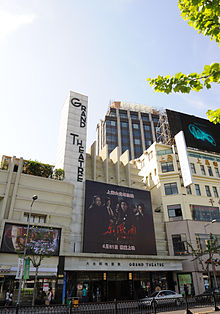Grand Theater (Shanghai)
The Grand Theater ( Chinese : 大 大 光明; pinyin : Dàguāngmíng Diànyǐngyuàn), also known as the Grand Cinema Gallery or Grand Cinema , is a historic movie theater in Shanghai , 216 Nanjing Road West, in the Huangpu district .
History and equipment
The building was designed by the Hungarian architect László Hudec (1893–1958) in the Art Deco style and inaugurated in 1933. Hudec also created the famous Park Hotel Shanghai , 170 Nanjing Road West, which opened the following year.
The opening of the cinema was a major event in Shanghai, attended by numerous celebrities, including Mei Lanfang , one of the most famous performers of the traditional Peking Opera .
For a long time it was considered the “best cinema in the Far East” and already had the most modern technology in its heyday. A translation system was installed at every seat, with the help of which the Chinese audience could enjoy foreign language films - via earphones - in simultaneous translation.
The exquisite furnishings with Italian marble and illuminated stucco work are also remarkable .
The cinema also temporarily served as a concert hall, especially for the Shanghai Symphony Orchestra . The orchestra brought here on 14 April 1936 under the leadership of Mario Paci , the 9th Symphony of Ludwig van Beethoven for Chinese premiere.
renovation
The building has been under the protection of the city administration since 1989 and has a corresponding sign in Chinese and English ("Monument under the Protection of Shanghai Municipality"). In 2008, it was extensively renovated for 120 million yuan . It was while retaining the historic structure by five small cinemas and a VIP - Lounge extended. The cinema has been open 24 hours a day since July 15, 2019. Today it has 1,900 seats.
The Grand Theater should not be confused with the Shanghai Grand Theater , the theater and opera house in Shanghai that opened in 1998 .
Literature (selection)
- Sheila Melvin and Jindong Cai, Rhapsody in Red: How Western Classical Music Became Chinese , New York 2004, ISBN 0-87586-179-2
